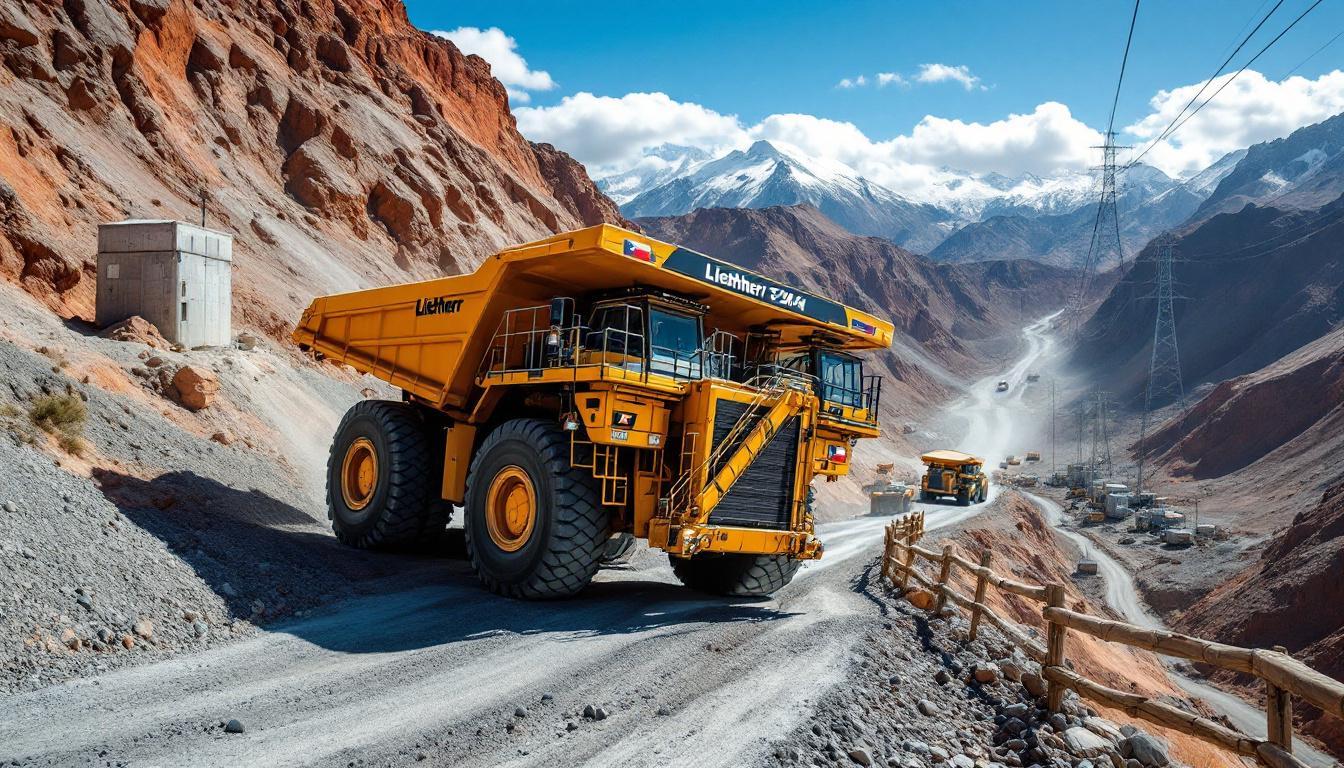What's Happening with Iron Ore Prices in Western Liaoning?
Western Liaoning's iron ore market is experiencing notable downward pressure, with current prices for Fe66% iron ore concentrates (wet basis, tax excluded) hovering between 880-890 yuan/mt. This represents a decline of 10-15 yuan/mt compared to the previous week, according to the latest data from Shanghai Metals Market (SMM).
The pricing situation reflects a complex interplay of market forces, with sellers showing significant resistance to further price reductions despite weakening buyer interest. This resistance has created a stalemate in the regional market, with transaction volumes remaining depressed as both sides hold firm on their price expectations.
"The current market represents a classic supply-demand standoff, with miners refusing to budge below certain price thresholds despite mounting pressure from downstream buyers," notes SMM's research team in their June 2025 market assessment.
Current Price Situation
The Fe66% iron ore concentrates have established a relatively narrow trading range, with most transactions concluding between 880-890 yuan/mt. Despite this apparent stability, market participants report increasing difficulty in finalizing deals at these levels, with many inquiries from buyers targeting prices below the current floor.
Iron ore sellers, particularly mines and beneficiation plants in the region, have demonstrated remarkable price discipline in the face of deteriorating market conditions. Many operations have signaled they would rather reduce output temporarily than sell below their cost thresholds, estimated at around 870-875 yuan/mt for efficient producers in the region.
Regional price variations within Western Liaoning itself are minimal, typically within a 5-10 yuan/mt range, with factors like transportation distance and specific quality parameters accounting for most differences. This relatively uniform pricing across the region suggests that market fundamentals, rather than localized factors, are driving the current price decline dynamics.
Weather Impact on Market Dynamics
The recent spate of rainfall across Western Liaoning has emerged as a critical factor affecting market dynamics. According to meteorological data, June 2025 has seen rainfall approximately 20% above seasonal averages, significantly higher than neighboring provinces.
This weather pattern has created multiple challenges for the iron ore supply chain:
- Increased moisture content in iron ore concentrates, often reaching 12-15% compared to the normal 8-10% range
- Reduced effective iron content per ton due to higher water weight
- Increased processing costs for buyers who must deal with additional drying
- Transportation difficulties on waterlogged roads and at loading facilities
- Quality consistency issues affecting blast furnace operations
The moisture impact is particularly significant for pricing, as wet-basis calculations mean buyers are effectively paying for water weight. Industry standards suggest that each 1% increase in moisture content above specification typically results in a 1-1.5% price discount, though current market conditions have amplified this effect.
"When moisture levels exceed 12%, many steel mills implement additional price adjustments to compensate for the extra processing requirements and reduced metal yield," explains a senior metallurgist at one of Western Liaoning's largest steel producers. "This creates a compound effect on already pressured prices."
Why Are Western Liaoning Iron Ore Markets Struggling?
The current struggles in Western Liaoning's iron ore markets stem from a confluence of factors that have created a persistent buyer-seller standoff, with neither side willing to significantly adjust their price expectations.
Buyer-Seller Standoff
Traders and steel mills have adopted an increasingly cautious approach to purchases, limiting their activity to essential restocking and opportunistic buying when temporary price dips occur. Market data indicates that trader inquiries have predominantly targeted prices below 880 yuan/mt, while most mines and beneficiation plants remain unwilling to sell below 890 yuan/mt.
This gap of approximately 10-15 yuan/mt between buyer and seller expectations has created a negotiation deadlock that has persisted for nearly two weeks. Transaction volumes have consequently fallen by an estimated 25-30% compared to seasonal averages.
Several key factors are fueling this standoff:
- Buyers anticipate further price declines due to seasonal factors
- Sellers face minimum profitability thresholds (estimated at 3-5% margins)
- Inventory positions remain relatively balanced, removing urgency from both sides
- Quality concerns (particularly moisture) strengthen buyers' negotiating positions
- Transportation challenges add uncertainty to delivery timelines
The standoff is particularly evident in contract negotiations, where term agreements that typically conclude by mid-month remain unfinalized as both parties hold out for more favorable conditions.
"We're seeing an unusually protracted negotiation period this season, with multiple rounds of back-and-forth before deals are finalized, if they close at all," observes Li Wei, a senior steel analyst at SMM.
Steel Industry Factors
The steel industry's current operating environment significantly influences iron ore purchasing behavior. Steel mills in the region are reportedly operating at 75-80% capacity utilization, below the 85-90% rates seen during peak season. This reduced production level directly impacts raw material requirements.
Steel mill profitability metrics have remained stubbornly average, with margins typically in the 3-5% range according to World Steel Dynamics data for Q1 2025. This constrained profitability has intensified cost-cutting efforts across the supply chain, with raw materials representing the largest single cost component.
The purchasing strategy of regional steel producers has evolved in response to these conditions:
- Just-in-time inventory management – maintaining only 15-20 days of iron ore stocks
- Price-triggered buying – accelerating purchases when temporary dips occur
- Quality segregation – prioritizing high-grade material only for premium steel products
- Supplier diversification – balancing domestic and imported sources to maintain leverage
- Contract restructuring – pushing for more flexible terms with price adjustment mechanisms
Despite these challenges, underlying demand remains relatively stable, characterized by what industry analysts term "rigid demand" – the minimum requirement to maintain basic operations. This baseline demand provides a floor for the market, preventing a more dramatic price collapse.
How Does This Compare to Broader Iron Ore Markets?
Western Liaoning's iron ore market exhibits distinct characteristics when compared to broader domestic and international markets, reflecting regional supply-demand dynamics and logistical realities.
Regional Market Variations
Iron ore pricing across China's producing regions shows notable divergence, with Western Liaoning's current prices approximately 4-5% lower than those in Hebei province despite similar quality specifications. This regional discount primarily reflects transportation disadvantages and the fragmented nature of local supply.
A comparative analysis reveals significant regional variations:
| Region | Fe66% Concentrate Price (yuan/mt) | Weekly Change | Key Market Factors |
|---|---|---|---|
| Western Liaoning | 880-890 | -10 to -15 | Weather issues, fragmented supply |
| Hebei | 920-930 | -5 to -10 | Proximity to major steel hubs |
| Shanxi | 900-910 | -8 to -12 | Better logistics infrastructure |
| Sichuan | 870-880 | -15 to -20 | Higher transportation costs |
These regional differences are amplified by transportation cost variations. Western Liaoning producers face freight costs approximately 40-50 yuan/mt higher than coastal regions when delivering to major steel manufacturing hubs, according to logistics data from Platts.
The quality differential also plays a role in regional price variations. While Western Liaoning concentrates typically feature Fe66% content, they often contain higher silica levels (7-9%) compared to imported Australian or Brazilian ores (3-5%), affecting their comparative value proposition.
"Regional iron ore markets in China increasingly operate as semi-independent ecosystems, with local supply-demand balances creating persistent price differentials that exceed transportation cost variations alone," explains Wang Ying, an iron ore analyst at CRU Group.
Seasonal Market Patterns
The current market conditions align with established seasonal patterns, though with greater intensity than historical averages. June-August typically represents a period of reduced activity in Northern China's iron ore markets, with prices historically declining 8-12% from peak season levels.
This seasonal pattern is driven by several consistent factors:
- Weather impacts – summer rainfall affecting both production and transportation
- Construction slowdown – reduced building activity during hot summer months
- Maintenance schedules – planned steel mill overhauls often scheduled for this period
- Inventory adjustments – deliberate destocking ahead of autumn restocking
Historical data suggests that similar price troughs typically resolve by September, with an average recovery of 5-7% as weather conditions improve and construction activity accelerates in autumn. However, market analysts note that the current standoff between buyers and sellers may prolong the recovery timeline.
"The seasonal effects we're seeing in 2025 follow established patterns, but the intensity of the buyer-seller standoff suggests a potentially longer duration than in previous years," notes an SMM market analyst in their June 2025 report.
What's the Outlook for Western Liaoning Iron Ore?
The near-term outlook for Western Liaoning's iron ore market suggests continued price pressure before potential stabilization, with several key factors determining the timeline and magnitude of any recovery.
Short-Term Price Projections
Market analysts project that the prices of iron ore in western Liaoning will likely remain within the current 880-890 yuan/mt range through late June, with limited catalysts for significant movement in either direction. SMM's forecast suggests that "prices of iron ore concentrates may remain in the doldrums next week," reflecting the persistence of current market fundamentals.
The short-term outlook is shaped by several imminent factors:
- Weather forecasts – Continued rainfall predicted through early July
- Steel mill production plans – No significant capacity increases expected before Q3
- Inventory positions – Currently balanced at 15-20 days of consumption
- Import competition – Stable seaborne prices providing a reference ceiling
The most probable price scenario according to industry analysts involves continued sideways movement with a slight downward bias, potentially testing the 870-880 yuan/mt range before finding more robust support. However, sustained levels below 870 yuan/mt appear unlikely given production cost structures at regional mines.
Potential catalysts that could prompt earlier price recovery include:
- Weather improvement – Earlier-than-expected cessation of rainfall
- Steel demand surprises – Unexpected infrastructure project announcements
- Supply disruptions – Maintenance or operational issues at major regional mines
- Policy interventions – Environmental inspections reducing available supply
Market Sentiment Indicators
Current market sentiment metrics reveal a cautious approach from all participants, with buyer confidence indicators showing notable pessimism. Purchasing manager surveys indicate an average sentiment score of 42/100 among iron ore buyers, well below the neutral threshold of 50.
Seller sentiment shows greater resilience, with a composite score of 58/100, reflecting confidence in the fundamental value of their product despite current market challenges. This sentiment gap helps explain the persistent negotiation tensions and limited transaction volumes.
Inventory management strategies provide additional insight into market psychology:
- Traders – Maintaining minimum working inventories (5-8 days)
- Steel mills – Operating with leaner stocks than seasonal averages (15-20 days vs. normal 20-25 days)
- Mines – Some building modest stockpiles (3-5 days of production) rather than selling at current prices
Risk assessment metrics suggest that buyers currently maintain a stronger negotiating position, but the balance could shift if weather conditions improve or steel demand strengthens unexpectedly. The relatively balanced inventory positions across the supply chain reduce the likelihood of panic selling or distressed purchases.
"The current market psychology reflects a classic standoff where neither side feels sufficient pressure to make major concessions," observes Li Wei of SMM. "This equilibrium, while uncomfortable for all participants, could persist until external factors force a resolution."
How Are Steel Mill Operations Affecting the Market?
Steel mill operational decisions and economic realities are exerting significant influence on iron ore demand insights in Western Liaoning, creating both constraints and opportunities.
Steel Production Economics
The current steel production economics present a challenging environment for mills in Northern China, with profitability metrics showing considerable pressure. Average steel mill profit margins hover around 3-5%, significantly below the 7-9% considered healthy for sustained operations and investment.
This constrained profitability directly impacts iron ore purchasing power and strategy. With raw materials representing approximately 60-65% of steel production costs, mill operators are intensifying efforts to secure price concessions from suppliers.
Key economic factors influencing steel mill operations include:
- Steel product pricing – Rebar prices averaging 4,100-4,200 yuan/mt, down 3-4% month-over-month
- Energy costs – Coal prices stabilizing after Q1 increases, currently at 1,800-1,900 yuan/mt
- Environmental compliance expenses – Increasing by approximately 15% year-over-year
- Labor costs – Rising at 4-5% annually, outpacing productivity improvements
- Capacity utilization – Currently 75-80%, below the 85-90% breakeven threshold for some operations
The relationship between steel prices and iron ore purchasing power shows a direct correlation, with every 100 yuan/mt change in steel prices typically translating to a 30-40 yuan/mt adjustment in acceptable iron ore costs. Current steel price trends therefore reinforce buyers' reluctance to accept higher iron ore prices.
"Steel mills are operating in a margin-constrained environment where every yuan saved on raw materials directly impacts bottom-line performance," explains a senior procurement manager at a major Liaoning steel producer. "This creates intense pressure to extract price concessions, particularly during seasonal demand lulls."
Steel Mill Purchasing Strategies
Steel mills have adopted increasingly sophisticated purchasing strategies to navigate the current market environment, balancing cost management, operational needs, and risk mitigation.
The predominant approach involves just-in-time inventory management, with mills maintaining only 15-20 days of iron ore stocks compared to historical norms of 25-30 days. This reduced inventory position minimizes capital costs but increases sensitivity to supply disruptions and price movements.
The purchasing behavior of regional steel mills follows several distinct patterns:
- Opportunistic buying – Accelerating purchases when temporary price dips occur
- Quality segmentation – Maintaining stricter standards for moisture and impurity levels
- Supplier diversification – Balancing domestic and imported sources to maintain leverage
- Contract restructuring – Pushing for more flexible terms with price adjustment mechanisms
- Strategic stockpiling – Selectively building inventory of high-quality materials
Risk management has become increasingly central to procurement strategies, with mills employing various approaches to mitigate price volatility:
- Hedging via futures markets – Approximately 25-30% of expected consumption
- Long-term contracts with pricing bands – Typically covering 40-50% of requirements
- Spot market purchases – Remaining 20-35% based on immediate needs and market conditions
The net effect of these strategies is a more disciplined and price-sensitive buying approach that places additional pressure on iron ore suppliers during periods of market weakness.
FAQ: Western Liaoning Iron Ore Market
How do moisture levels affect iron ore pricing?
Moisture content significantly impacts iron ore pricing through multiple mechanisms:
Economic Impact: High moisture content effectively dilutes the metal content by weight, reducing the actual Fe percentage per ton. For example, Fe66% concentrate with 15% moisture instead of the standard 8% contains approximately 7-8% less usable iron per ton.
Processing Challenges: Excessive moisture creates operational difficulties at steel mills, including:
- Additional energy consumption for drying (approximately 15-20 kWh per percentage point of excess moisture)
- Increased coke consumption in blast furnaces (roughly 0.5-1% per point of excess moisture)
- Material handling issues during unloading and stockpiling
- Potential freezing during winter months
Price Adjustments: Industry pricing standards typically apply discounts of 1-1.5% per percentage point of moisture above specification. During rainy seasons, these discounts can increase to 1.5-2% as overall market quality deteriorates.
Contract Specifications: Standard contracts in Western Liaoning typically specify 8% moisture for Fe66% concentrates, with variation allowances of ±1%. Moisture levels currently averaging 12-15% therefore trigger significant price adjustments.
"Moisture content is particularly critical during rainy seasons when the cumulative impact across the supply chain—from mining to transportation to processing—creates a multiplicative effect on costs and operational efficiency," explains a senior metallurgist from a regional steel producer.
What factors could trigger a price recovery in Western Liaoning?
Several potential catalysts could initiate price recovery in the regional market:
Weather Improvement: Cessation of rainfall would immediately improve product quality by reducing moisture content. Historical patterns suggest that two consecutive weeks of dry weather can reduce average moisture levels by 3-4 percentage points.
Steel Industry Economics: Improved steel mill profitability would increase raw material purchasing power. Analysts suggest that steel profit margins exceeding 6-7% typically correlate with more aggressive iron ore procurement.
Seasonal Demand Recovery: Historical patterns indicate strengthening demand beginning in late August as construction activity accelerates after the summer lull. This typically drives a 5-7% price recovery.
Supply Constraints: Any disruptions to
Want to Invest in the Next Major Mineral Discovery?
Discover significant mineral opportunities before the market with Discovery Alert's proprietary Discovery IQ model, which transforms complex ASX announcements into actionable investment insights. Explore why major discoveries can lead to exceptional returns by visiting Discovery Alert's dedicated discoveries page and begin your 30-day free trial today.




